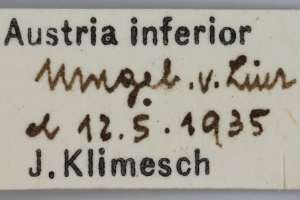1. Lebendfotos
1.1. Männchen
1.2. Weibchen
1.3. Raupe, Raupensack
1.4. Puppe
2. Diagnose
2.1. Männchen
2.2. Weibchen
2.3. Erstbeschreibung
3. Biologie
3.1. Habitat
4. Weitere Informationen
4.1. Etymologie (Namenserklärung)
„politus fein gebildet, glatt.“
4.2. Andere Kombinationen
- Psyche politella Ochsenheimer, 1816 [Originalkombination]
4.3. Synonyme
- Taleporia clandestinella Zeller, 1852
- Taleporia szocsi Sieder, 1955
4.4. Taxonomie
Nach Arnscheid & Weidlich (2017) gehören die Synonyme Solenobia lefebvriella Duponchel, 1843 und Solenobia minorella Duponchel, 1843 nicht hierher sondern zu Taleporia tubulosa.
4.5. Faunistik
Weidlich (2015: 1920) erklärt: "Von mehreren Lokalitäten im Verbreitungsgebiet (Italien, Slovenien, Kroatien) der ssp. clandestinella züchtete der Autor die Imagines von Ende März bis Ende Mai. Diese Unterart lebt in xerothermen Habitaten, hauptsächlich in der Karstlandschaft."
Volkova et al. (2022: 114) schreiben zur Wolga-Region im europäischen Teil Russlands zu "Taleporia pr. politella": "Material: 4 ♀, Surskoe District, environs of the village Lava, bilberry-Ledum marsh, 54.479973N, 46.901823E, 16.V.2021, leg. S.N. Kryuchkov, Ju.S. Volkova (Fig. 48, site 2). Biology. In Europe, inhabits xeroterms and open landscapes with rocks. In Russia, it is found in the southern taiga subzone. Caterpillars feed on algae, lichens, and mosses. Adults occur from April to May very early in the morning. Identification of this species from the territory of Ulyanovsk Oblast is preliminary and needs to be confirmed by the barcoding. Distribution in Russia. Recorded from the Chuvash Republic (Lastukhin, 2010), under the question mark (?) from the Karelian and European Northwestern Regions (Sinev & Lovtsova, 2019). New record from the Volga-Ural Region."
(Autor: Erwin Rennwald)
4.6. Literatur
- Arnscheid, W.R. & M. Weidlich (2017): Psychidae. — In: Karsholt, O., Mutanen, M. & M. Nuss [edit.]: Microlepidoptera of Europe. Volume 8: 1-423; Leiden & Boston (Brill).
- Hättenschwiler, P. (1997): Taleporia politella ssp. clandestinella. — In: Pro Natura – Schweizerischer Bund für Naturschutz (Hrsg.) (1997): Schmetterlinge und ihre Lebensräume. Arten, Gefährdung, Schutz. Schweiz und angrenzende Gebiete. Band 2: 215-217. Egg (Fotorotar AG).
- Erstbeschreibung: Ochsenheimer, F. (1816): Die Schmetterlinge von Europa 4: V-X, [11]-225. Leipzig (Gerhard Fleischer der Jüngere).
- Sauter & Hättenschwiler (2004): Zum System der palaearktischen Psychidae. 3. Teil: Bestimmungsschlüssel für die Säcke. — Nota lepidopterologica 27 (1): 59–69 [Digitalisat auf archive.org].
- Volkova, J.S., Prozorov, A.M., Kryuchkov, S.N., Pavlov, P.O., Yakovlev, R.V. & V.V. Anikin (2022): Fauna of Psychidae (Lepidoptera) of the Ulyanovsk Oblast (Middle Volga, Russia). — Ecologica Montenegrina, 58: 109-121. [zum PDF-Download auf biotaxa.org]
- Weidlich, M. (2015): Beobachtungen zur Psychidenfauna Italiens mit der Neubeschreibung einer Dahlica Enderlein, 1912 (Lepidoptera: Psychidae). — Linzer biologische Beiträge 47 (2): 1909-1934. [PDF auf zobodat.at]

![Kein Vorkommen in Deutschland [Fehlbestimmung / Falschangabe]](/res/img/flag/de.png)

![Vorkommen in Österreich [Huemer (2013: NR 0330)]](/res/img/flag/at.png)
![Fragliches Vorkommen in Russland (europäischer Teil bis Manytsch-Niederung) [Sinev (2019)]](/res/img/flag/ru.gif)
![Fragliches Vorkommen in Weißrussland [Pisanenko, A., Švitra, G. & V. Piskunov (2019): Checklist of Lepidoptera recorded from Belarus]](/res/img/flag/by.gif)
![Vorkommen in Polen [Buszko J. & J. Nowacki [eds] (2017): A Distributional Checklist of the Lepidoptera of Poland]](/res/img/flag/pl.gif)
![Vorkommen in Tschechien [Laštůvka, Z. & J. Liška (2011): Komentovaný seznam motýlů České republiky]](/res/img/flag/cz.gif)

![Vorkommen in Ungarn [Pastorális et. al. (2018): A Magyarországon előforduló molylepke-fajok névjegyzéke]](/res/img/flag/hu.gif)
![Vorkommen in Frankreich (europäisches Territorium ohne Korsika) [Vandromme et al. (2020): Liste systématique et taxinomique des Lépidoptères de France]](/res/img/flag/fr.gif)
![Vorkommen in Spanien (Festland) [Vives Moreno A. (2014)]](/res/img/flag/es.gif)
![Vorkommen in Italien (Festland und kleine festlandsnahe Inseln) [Gaedike et al. (1995): Checklist delle Specie della Fauna Italiana 81]](/res/img/flag/it.gif)
![Vorkommen in Slowenien [Carnelutti (1992): The Red List of Endangered Macrolepidoptera in Slovenia]](/res/img/flag/si.gif)

![Vorkommen in Rumänien [Rákosy L. & M. Goia (2021): Lepidopterle din România: lista sistematică şi distribuţie]](/res/img/flag/ro.gif)
![Vorkommen in Bulgarien [Rebel H. (1903): Lepidopterenfauna der Balkanländer - Bulgarien und Ostrumelien]](/res/img/flag/bg.gif)
























